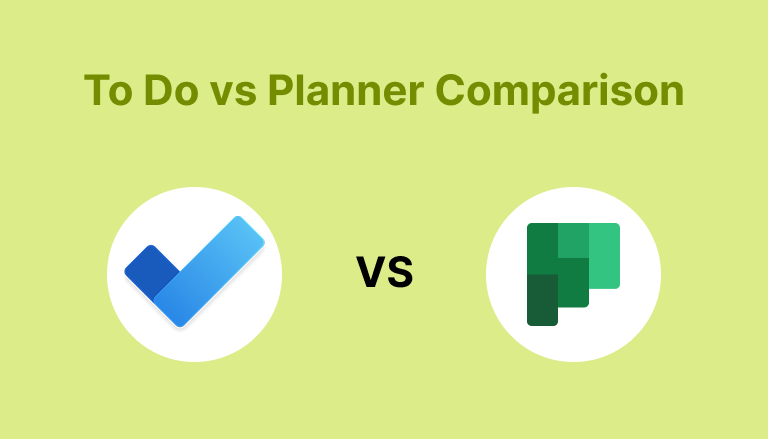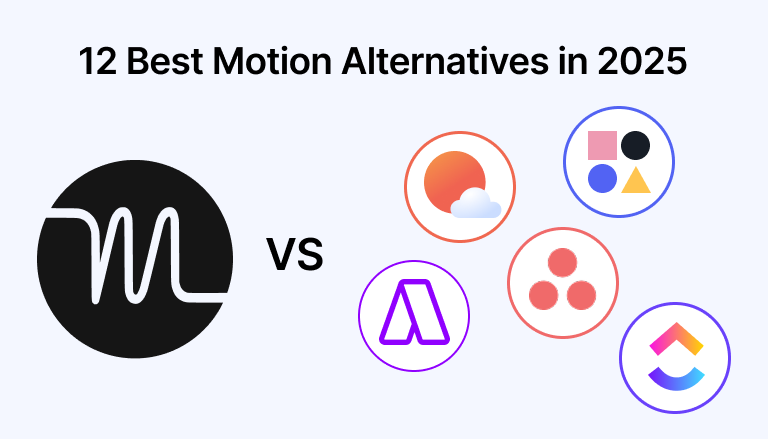Motion has made a name for itself by combining AI with daily planning. It takes your tasks, auto-schedules them on your calendar, and reshuffles your day when something new pops up. For some, that’s a dream—one less thing to think about. For others, it feels like losing control of your own schedule. And that’s where the problem begins.
As productivity styles become more personal and nuanced, not everyone wants their calendar micromanaged by AI. Some need more flexibility, some want deeper customization, and others just want a tool that doesn’t assume how they should work. That’s where this list comes in. We’ve rounded up the top alternative Motion tools in 2025.
That said, here are the most common limitations that lead people to explore other options:
What Are the Limitations of Using Motion?
Even with its strong AI-powered features, many Motion users find themselves frustrated by how it handles planning in practice
- Limited Manual Control: Motion’s automation can override your preferences, making it hard to manually plan around deep work or fixed priorities.
- AI Can Miss the Mark: If the AI misjudges your priorities or reschedules poorly, you may spend more time fixing its changes than benefiting from them.
- Steep Learning Curve: Getting comfortable with Motion’s AI-driven system can take time—something not all users are willing to invest.
- Basic Collaboration Tools: It lacks robust features for teams, like shared project dashboards, advanced reporting, or real-time syncing.
- No Free Plan: Unlike many competitors, Motion doesn’t offer a free tier—making it less accessible for budget-conscious users.
- Not Ideal for Project Management: Missing features like kanban boards, dependencies, or timeline views make it less suitable for complex workflows.
Looking for a tool that fits your workflow better than Motion? Whether you’re a solopreneur, manager, freelancer, or part of a remote team, here are some of the top alternatives to consider.
12 Best Alternative Motion Tools in 2025
This list breaks down the top alternatives—whether you need more manual control, smarter scheduling, or a lighter, distraction-free planner. Each option is matched to a specific use case to help you find the best fit quickly.
1. Akiflow – Best for Control & External Task Aggregation
Akiflow centralizes your tasks from multiple tools and lets you manually time block them on your calendar—without AI interference.
Key Features
- Unified task inbox from tools like Gmail, Slack, Notion, Asana, Trello, and more
- Manual time blocking directly on Google or Outlook calendars
- Keyboard-first interface with powerful shortcuts and command bar
- Smart snooze, recurring tasks, and labels for fast triage
- Built-in meeting scheduler with booking links
- Focus mode for distraction-free deep work sessions
Who Is It For?
Akiflow is ideal for individuals who:
- Prefer manual control over auto-scheduling
- Use multiple tools and want a single place to manage tasks
- Follow a time-blocking or deep work routine
- Need speed and structure, without complexity or bloat
- Work solo or in small teams without complex project needs
| Pros | Cons |
| Fast and intuitive planningIntegrates well with major task & calendar toolsDistraction-free, keyboard-driven workflowDesigned for intentional daily planningIncludes lightweight meeting scheduling | No automatic task scheduling (by design)Limited collaboration features for larger teamsNo kanban or multi-project views |
- 7-day free trial
- Pro Monthly: $34/month
(Billed monthly) - Pro Yearly: $9.50/month
(Billed annually at $114 total)
– Includes 50% parity discount for India
2. Sunsama – Best for Mindful Manual Planning
Sunsama is designed for intentional daily planning. It helps you review tasks, block time, and structure your day manually—one step at a time.
Key Features
- Daily and weekly planning flows
- Drag-and-drop time blocking into your calendar
- Task imports from tools like Asana, Trello, Notion, Gmail
- Built-in time tracking and planning analytics
Who Is It For?
- Professionals who prefer planning their day mindfully
- Solopreneurs or remote workers aiming for balance over speed
- People who want structure without automation
| Pros | Cons |
| Encourages thoughtful, realistic planningClean, minimal interfaceIntegrates with popular productivity tools | No auto-schedulingNot ideal for fast-paced or collaborative workflows |
- 14-Day Free Trial Unlimited access to all features, no credit card required.
- Monthly Subscription: $20/month, billed monthly.
- Yearly Subscription: $16/month, billed annually ($192/year).
3. Reclaim AI – Best for Smart Scheduling and Time Protection
Reclaim helps busy professionals automatically defend focus time by intelligently blocking tasks, habits, and meetings based on your real calendar availability.
Key Features
- Auto-scheduling for tasks, recurring routines, and breaks
- Smart 1:1s that find ideal meeting times for both parties
- Calendar sync and adjustments based on real-time availability
- Time tracking insights and productivity stats
Who Is It For?
- People who spend most of their day in meetings
- Teams that want smarter internal scheduling
- Users who don’t need full task/project management, just calendar control
| Pros | Cons |
| Set-it-and-forget-it style schedulingSyncs habits and tasks into your calendarWorks well with tools like Asana, Todoist, and Jira | Limited task management featuresOnly works with Google Calendar (Outlook support is limited) |
- Lite: Free forever
- Starter: $8/month per user
- Business: $12/month per user
- Enterprise: $18/month per user
4. Asana – Best for Structured Project Management
Asana is a project management tool built for organizing tasks, timelines, and workflows—especially across larger teams and departments.
Key Features
- Project views: List, Board, Timeline, Calendar
- Task dependencies, milestones, and workload management
- Reporting dashboards and progress tracking
- Integrations with Slack, Google Workspace, Zoom, and more
Who Is It For?
- Teams managing complex projects
- Organizations needing task visibility and accountability
- Managers looking for structure and reporting
| Pros | Cons |
| Scales well for mid-sized and large teamsStrong collaboration and tracking toolsReliable for cross-functional workflows | Requires setup time for team adoptionCan be overkill for solo users |
- Monthly Subscription: $10.99 per user/month, billed monthly.
- Yearly Subscription: $9.49 per user/month, billed annually ($113.88/year).
5. ClickUp – Best All-in-One Alternative for Teams
ClickUp combines tasks, docs, calendars, goals, and collaboration into one platform. It’s highly customizable and suited for teams managing complex workflows.
Key Features
- 15+ views: List, Calendar, Board, Gantt, Timeline, etc.
- Built-in docs, goals, and time tracking
- Automations, dashboards, and reporting
- ClickUp AI for writing, summarizing, and planning tasks
Who Is It For?
- Teams managing multiple projects
- Users who want everything in one place—tasks, docs, chat, goals
- Organizations that need structure + flexibility
| Pros | Cons |
| Scales across teams and departmentsAll-in-one tool with deep customizationFree plan for individuals and small teams | Can feel overwhelming at firstMobile experience is limited compared to desktop |
- Free Forever Plan: Ideal for personal use, includes 100MB storage, unlimited tasks, Kanban boards, collaborative docs, and more.
- Unlimited Plan: $7 per user/month, billed monthly.
- Business Plan: $12 per user/month, billed monthly.
- Enterprise Plan: Custom pricing.
6. Routine – Best Free Planner for Personal Use
Routine is a minimalist daily planner designed for individuals who want to manage tasks, habits, and calendar events in one simple interface.
Key Features
- Tasks, notes, and calendar in a unified view
- Habit tracking and daily planning
- Native desktop and mobile apps
- Google Calendar integration
Who Is It For?
- Students, freelancers, or individuals looking for a clean, free planning tool
- Anyone who prefers a lightweight alternative to full-blown productivity apps
| Pros | Cons |
| Free forever planEasy to use and beautifully designedGreat for personal routines and light planning | Not built for collaboration or team workflowsNo advanced task/project management features |
- Free plan available
- Paid plans (for premium features) in development
7. Calendly – Best for Simple Meeting Scheduling
Calendly automates meeting scheduling by syncing with your calendar and letting others book time based on your real availability.
Key Features
- Custom scheduling links
- Google, Outlook, and Microsoft 365 calendar sync
- Automated reminders and follow-ups
- Round-robin and group meeting options
Who Is It For?
- Professionals who book a lot of 1:1 or external meetings
- Users who want a standalone scheduling tool without full task management
| Pros | Cons |
| Eliminates scheduling back-and-forthEasy setup and clean interfaceFree plan supports basic needs | Limited workflow automationNot suitable as a full productivity or planning tool |
- Free Plan: Always free, perfect for personal use.
- Standard Plan: $10 per seat/month, billed monthly.
- Teams Plan: $16 per seat/month, billed monthly.
- Enterprise Plan: Starts at $15,000/year.
8. Notion – Best for Custom Setups (Not Daily Planning)
Notion is a flexible workspace that can be configured into anything—from wikis and databases to basic task boards—but it’s not built for structured daily planning out of the box.
Key Features
- Customizable pages, databases, and templates
- Collaborative editing, comments, and mentions
- Integration with tools like Slack, Google Drive, and GitHub
- Embeds for calendars, kanban boards, and more
Who Is It For?
- Technical users or small teams building custom workflows
- People who enjoy creating their own systems from scratch
| Pros | Cons |
| Extremely flexible and modularGreat for documentation, knowledge bases, and wikisActive community with endless templates | Not ideal for time blocking or daily task planningHigh setup time for productivity workflowsPoor adoption in larger teams without clear processes |
- Free Plan: Perfect for individuals, includes collaborative workspace, basic analytics, 7-day page history, and up to 10 guest invites.
- Plus Plan: $10 per seat/month, billed monthly.
- Business Plan: $15 per seat/month, billed monthly.
- Enterprise Plan: Custom pricing.
9. Trello – Best for Kanban-Style Simplicity
Trello is a visual task management tool that uses boards, lists, and cards to help individuals and teams track work in a flexible, easy-to-understand layout.
Key Features
- Drag-and-drop kanban boards
- Task checklists, due dates, and attachments
- Power-ups for calendar view, integrations, and automation
- Team collaboration with comments and labels
Who Is It For?
- Individuals or small teams who prefer visual task tracking
- Users looking for a simple, low-friction way to organize workflows
| Pros | Cons |
| Intuitive and beginner-friendlyEasy to customize with Power-UpsFree plan supports most basic use cases | Limited for complex project or time-based planningCan become cluttered as projects scale |
- Free Plan: $0, ideal for individuals or small teams. Includes unlimited cards, up to 10 boards per Workspace, Power-Ups, custom backgrounds, and 250 automation command runs per month.
- Standard Plan: $5 per user/month, billed annually ($6 billed monthly).
- Premium Plan: $10 per user/month, billed annually ($12.50 billed monthly).
- Enterprise Plan: $17.50 per user/month, billed annually
10. Clockwise – Best for Focus-Time Optimization at Scale
Clockwise optimizes your team’s calendar by automatically rescheduling meetings to free up longer blocks of focus time—especially useful in meeting-heavy organizations.
Key Features
- Smart meeting scheduling and conflict resolution
- Focus time protection for individuals and teams
- Auto-adjusts recurring meetings for better alignment
- Integrates with Google Calendar and Slack
Who Is It For?
- Teams overwhelmed by meetings
- Managers looking to protect focus time across schedules
- Companies with shared calendars and constant scheduling conflicts
| Pros | Cons |
| Automatically optimizes for deep workReduces calendar fragmentationLightweight and integrates into existing tools | No task or project managementGoogle Workspace only (no native Outlook support) |
- Free Plan: $0 per user/month.
- Teams Plan: $6.75 per user/month, billed annually.
- Business Plan: $11.50 per user/month, billed annually.
- Enterprise Plan: Custom pricing.
11. BeforeSunset AI – Best for End-of-Day Planning and Journaling
BeforeSunset AI is a unique productivity app that combines task planning with end-of-day reflections. It’s built for users who want a balance between structure and mindfulness.
Key Features
- AI-assisted daily planning and scheduling
- End-of-day summaries and reflections
- Calendar and task list integration
- Focus mode with session timers and music
Who Is It For?
- Individuals who value journaling and mindfulness
- Users who prefer guided planning with light automation
- Professionals looking for a calming, reflective productivity tool
| Pros | Cons |
| Combines planning and wellness in one appGreat for building sustainable daily routinesBeautiful, calming interface | Still maturing as a productLacks deep team or project management features |
- Pro Plan: $8 per month, billed monthly ($96 annually).
- Team Pro Plan: $12 per member/month, billed monthly ($144 annually).
12. Todoist – Best for Minimalist Task Management
Todoist is a lightweight, list-based task manager with strong cross-platform support and simple project organization. It’s great for users who want clarity without complexity.
Key Features
- Quick task capture with natural language input
- Projects, labels, priorities, and recurring tasks
- Shared task lists for light collaboration
- Integrations with Google Calendar, Slack, and more
Who Is It For?
- Individuals who want a distraction-free to-do list
- Small teams or families managing shared tasks
- Users who prefer simplicity over full project systems
| Pros | Cons |
| Easy to learn and fast to useWorks across all devicesFree tier for personal use | Not suitable for managing complex projectsLimited visual views (no native kanban, timeline, etc.) |
- Beginner (Free): 5 projects, basic reminders, 3 filters
- Pro ($2/mo): 300 projects, calendar view, custom reminders, AI
- Business ($6/user/mo): Team workspace, 500+ projects, roles & permissions
If you’ve made it this far, you probably have a better sense of what Motion does and doesn’t do well for your workflow. But with so many alternatives, how do you actually decide which one’s worth trying?
How to Choose the Right Alternative Motion Tool
Use this 4-part checklist to find a tool that fits your style, workflow, and goals.
1. Identify what Motion is replacing for you
Is it:
- A daily planner?
- A calendar scheduler?
- A project management tool?
- All of the above?
Get clear on which core features you actually used in Motion—because not every alternative replaces everything.
2. Choose your planning style
- Want full control? → Look for manual time-blocking tools like Akiflow or Sunsama
- Prefer hands-off automation? → Tools like Reclaim AI and Clockwise are a better match
- Need a mix? → Try platforms like ClickUp, which offer both manual and automated workflows
3. Consider your context
Are you:
- Working solo? → Focus on tools with a clean interface and strong integrations (Akiflow, Routine)
- Managing a team? → Prioritize collaboration, reporting, and task visibility (ClickUp, Asana)
- Mostly scheduling meetings? → A simple tool like Calendly might be all you need
4. Test with real tasks
The only way to know if a tool fits is to try it. Pick one or two options from this list and:
- Set up your real calendar and task flow
- Plan a full day or week with it
- See how it holds up under actual work pressure
Most of these tools offer free trials—use them to evaluate based on your workflow, not just features.
Final Thoughts
Motion is a powerful tool—especially for those who want to automate their schedules and reduce decision fatigue. But productivity isn’t one-size-fits-all. For many professionals, Motion’s rigid structure, reliance on AI, and lack of flexibility can create more friction than focus.
Thankfully, there’s no shortage of alternative Motion tools that cater to different planning styles, team sizes, and workflows.
If you’re looking for a fast, focused, and flexible planner built for control—not complexity—Akiflow is a great tool to start.

Getting Things Done in 5 Steps: The Secret to Mastering Your Workflow
Master your workflow with the Getting Things Done method. Discover 5 simple steps to stay organized, reduce stress, and boost productivity.

Microsoft To Do vs Planner: Which Task Management Tool Is Right for You?
Compare Microsoft To Do vs Planner. Discover ideal scenarios for task management and team collaboration. Choose the right tool and boost productivity today!

Best Task Management Tools and Techniques for 2025
Boost efficiency with task management tools like ClickUp and Trello. Choose the right tool for your team, improve productivity, and reduce burnout. Explore now!
